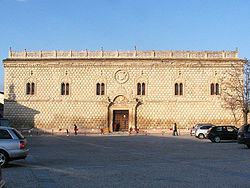
Plateresque, meaning "in the manner of a silversmith", was an artistic movement, especially architectural, developed in Spain and its territories, which appeared between the late Gothic and early Renaissance in the late 15th century, and spread over the next two centuries. It is a modification of Gothic spatial concepts and an eclectic blend of Mudéjar, Flamboyant Gothic and Lombard decorative components, as well as Renaissance elements of Tuscan origin.

The Isabelline style, also called the Isabelline Gothic, or Castilian late Gothic, was the dominant architectural style of the Crown of Castile during the reign of the Catholic Monarchs, Queen Isabella I of Castile and King Ferdinand II of Aragon in the late-15th century to early-16th century. The Frenchman Émile Bertaux named the style after Queen Isabella.
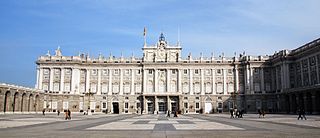
Spanish architecture refers to architecture in any area of what is now Spain, and by Spanish architects worldwide. The term includes buildings which were constructed within the current borders of Spain prior to its existence as a nation, when the land was called Iberia, Hispania, or was divided between several Christian and Muslim kingdoms. Spanish architecture demonstrates great historical and geographical diversity, depending on the historical period. It developed along similar lines as other architectural styles around the Mediterranean and from Central and Northern Europe, although some Spanish constructions are unique.
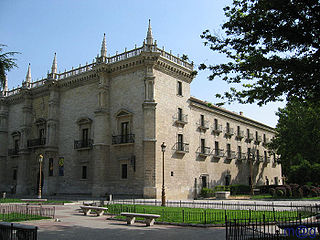
The Palacio de Santa Cruz is an Early-Renaissance palace in Valladolid, in Castile and León, Spain. Construction began in 1486 but in 1490 building came under the control of Lorenzo Vázquez de Segovia who finally completed it in 1491.

Lorenzo Vázquez de Segovia was a 15th-century Spanish architect and builder noted for completing the Santa Cruz Palace in 1491 in Valladolid and a number of other handsome buildings in the Castile region of western Spain.

Spanish Renaissance architecture was that style of Renaissance architecture in the last decades of the 15th century. Renaissance evolved firstly in Florence and then Rome and other parts of the Italian Peninsula as the result of Renaissance humanism and a revived interest in Classical architecture. In Spain, the Renaissance began to be grafted to Gothic forms as mathematicians and engineers rediscovered building as one of the technological sciences. In the time of King Felipe II (1556–1589), the Renaissance influence expanded throughout the territory thanks to the dissemination of architectural treatises.

Portuguese architecture refers to both the architecture of Portugal's modern-day territory in Continental Portugal, the Azores and Madeira, as well as the architectural heritage/patrimony of Portuguese architects and styles throughout the world, particularly in countries formerly part of the Portuguese Empire.
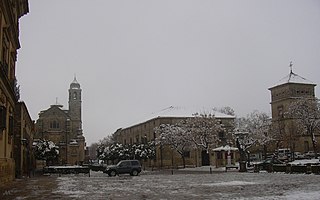
Vázquez de Molina Square, situated in Úbeda (Jaén), in the Autonomous Region of Andalusia (Spain), is one of the best examples of Renaissance architecture in Spain. The Spanish Renaissance architectural value of this square was one of the motives for UNESCO's decision to declare Úbeda a World Heritage site in July 2003.
The Sicilian title Duke of Bivona stems from the middle 16th century. Bivona is in Sicily, which had been conquered by Peter III of Aragon in 1282. It was given to people related to the powerful medieval Aragonese family of Luna, Zaragoza.

Íñigo Lopez de Mendoza y Pimentel, 4th Duke of the Infantado was a Spanish nobleman. He was made a Knight of the Order of the Golden Fleece in 1546, the 193rd to receive that distinction. Duke of the Infantado is a title first granted in 1475 and was inherited upon his father's death in 1531. He was also 5th Count of Saldaña, 4th Marquess of Argüeso, 4th Marquess of Campóo, 5th Marquess of Santillana, 5th Count of Real de Manzanares, Señor de Mendoza, Señor de Hita, and Señor de Buitrago.

La Casa de Pilatos is an Andalusian palace in Seville, Spain, which serves as the permanent residence of the Dukes of Medinaceli. It is an example of an Italian Renaissance building with Mudéjar elements and decorations. It is considered the prototype of the Andalusian palace.

Pedro Afán de Ribera, 1st Duke of Alcalá de los Gazules, Virrey y Capitán General de Cataluña y Nápoles, also known as Pedro Enriquez Afan de Ribera or Per Afán de Ribera y Portocarrero or Perafán de Ribera y Portocarrero, was a Spanish nobleman most notable for his twelve-year-long service as Viceroy of Naples, Viceroy of Catalonia and 1st Duke of Alcalá de los Gazules.

The Palacio de Xifré is a Madrilenian palace now disappeared that was in the Paseo del Prado, at the corner Calle de Lope de Vega, opposite the Prado Museum. It was one of the best examples of Neo-Mudéjar architecture in Madrid and one of the palaces that the Spanish financial elite of the second half of the 19th century had built along the paseos del Prado, Recoletos and la Castellana.

The Palacio del Duque de Uceda also known as Palacio de los Duques de Medinaceli was a palace located in Plaza de Colón in Madrid.

The Palacio del Marqués de Alcañices, also known as Palacio de Alcañices, was a building, now disappeared, which was located in the Calle de Alcalá of Madrid on the land that was other building that occupied Luis Méndez de Haro 6th Marquis del Carpio, a favorite of Philip IV. It belonged to the parish of San Sebastián, and occupied the number 74 of the modern numbering of the street; its other façade bordering the Paseo del Prado. Was named after its owners, the last one José Osorio y Silva, mentor of Alfonso XIII, known as Pepe Osorio and the Grand Duke of Sesto, who also held the title of Marquess of Alcañices, among others.

The Palacio de los Duques de Maqueda, also known as Palacio de La Cava is a palace located in Toledo, in Castile-La Mancha, Spain. In the vicinity of the Puerta del Cambrón and the Monastery of San Juan de los Reyes was this palace built by the Cárdenas family, Dukes of Maqueda and magistrates of Toledo between the 16th and 18th centuries. Of the remains that are conserved it emphasizes the portal, a unique one of Mudéjar style built in the 14th century.
The Palace of the Dukes of Alba is a ducal palace in Piedrahita, province of Ávila, Spain. The palace was constructed by Jaime Marquet between 1755 and 1766 as a summer residence for the Dukes of Alba, and currently houses a school.
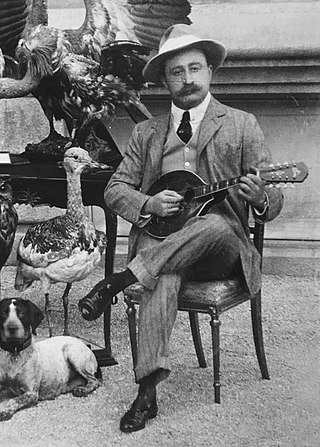
Luis Jesús Fernández de Córdoba y Salabert, 17th Duke of Medinaceli, GE, was a Spanish nobleman and trophy hunter. He was born the world's most titled person since his father, the 16th Duke, had died months before in a hunting accident. He was 11 times a duke, 17 a marquess, 15 a count and 4 a viscount.
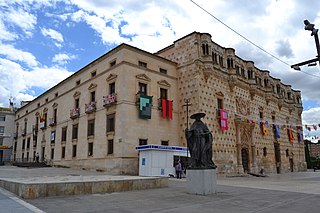
The Museum of Guadalajara is a State-owned museum in Guadalajara, Spain. Opened in 1838, it is the oldest provincial museum in the country. It features sections of Fine Arts, Archaeology and Ethnography. It is hosted at the Palacio del Infantado since 1973.
